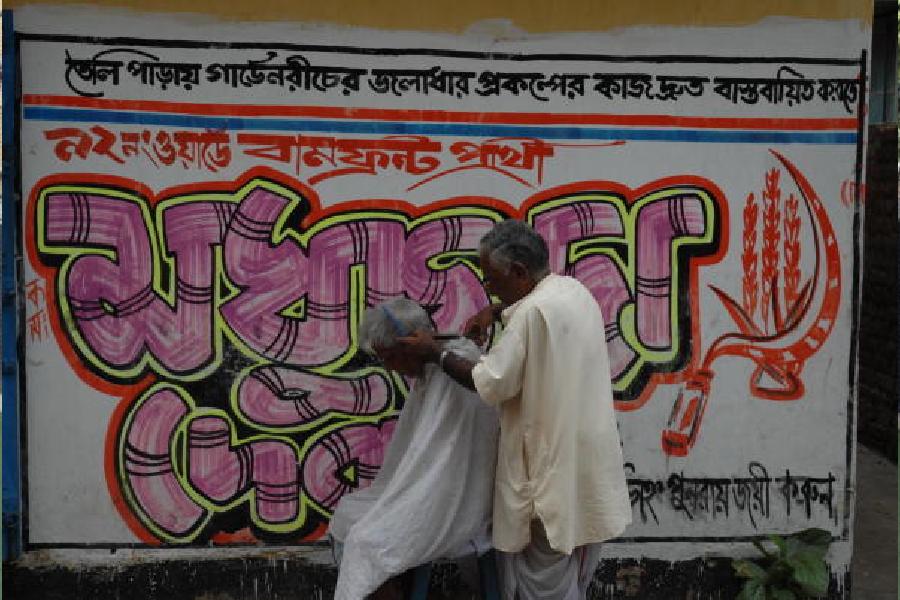Once upon a time, Calcutta’s walls spouted political graffiti, election or no election. A dive into the archives yields these among far too many others: “They devide, we unite. Give unity a chance (sic)” by the BJP or “Shabdhan. Don’t vote for Congress (I)” by the DYFI with a sketch of what is supposed to be Siddhartha Shankar Ray or “Bangla theke Nano gelo, Didir kiba eshe gelo” by the CPI(M). The tour of the archives feels a bit like time travel. Old slogans, old battle idiom, caricatures of figures long gone or retired — Rajiv Gandhi, A.B. Vajpayee, Narasimha Rao, Ajit Panja, Buddhadeb Bhattacharjee riding a snail.
“It was the Left parties that started the tradition of wall writing,” maintains the CPI(M)’s Ajoy Dasgupta, who works for the party mouthpiece Ganashakti. First or not, there is little doubt that the Left parties boasted the most creative wall writing. There was “Yeh Azaadi Jhootha Hain” post-Independence and “Gali gali mein shor hain, Rajiv Gandhi chor hain” from 1989, post the Bofors scandal.
“Humour was a tool of critique as well as self-reflexivity. The tongue-in-cheek playfulness and rhyming made them easy to be cited and recited,” writes Swati Chattopadhyay about wall-writing in her essay The Politics of Popular Art in India in the book The Routledge Companion to Art and Politics. It seems, every neighbourhood had a comrade known for his humour or writing skills as chief wall writer.
And then — the wall shifted.
Wall writers now key in their smart slogans on social media walls and WhatsApp posts. And instead of a literary bent, wall campaign has acquired a visual slant. Since the trend now is reels, the posts on the CPI(M) West Bengal Facebook page are mostly videos, a news clip, a speech or a TV debate or the AI-generated anchor Samata. The party’s Instagram account is full of posters of the party’s Lok Sabha candidates, explanatory reels on current topics like electoral bonds and so on and so forth. There are posters for WhatsApp — ready reckoners of candidates, Comrade X or Y, obviously crafted with care, some a tad too wordy. The social media campaign is not limited to the party’s official handles. Individual comrades do their bit on their own timelines.
The social media cell of the CPI(M) in Bengal was founded in 2014. The handful of people in the tiny office room on Alimuddin Street were all volunteers, just like the wall artists. Today, the social media wing has got its separate office; but 90 per cent of its workforce still works for free.
The craft of wall writing took off right and proper in the 1960s. The Left Front was yet to begin its historic 30-year reign and wall writing was a guerilla affair. “If the party had a michhil (procession) from Jadavpur to Garia, some people would quickly write on the wall with tar under the cover of the procession,” says Dasgupta.
The story goes that Naxalites would write slogans on the walls of the crematorium with charcoal from the pyres of slain comrades. It was both defiance and tribute. Once the Left Front came to power, wall writing turned into an art. Walls were first whitewashed then bhusho kali (soot) was mixed with sirish atha (cheap gum made from the horns and hooves of cows) to form the paint used for walling. In later years, poster colours and Fevicol replaced the soot and non-vegan gum.
Wall writing was both a bonding activity and a public outreach programme. People from the neighbourhood would gather in groups and head out to fill walls that had already been claimed “All walls CPM” is what was scribbled on walls claimed by the party. And yes, there were disputes between parties regarding the use of walls and the party in power got access to the choicest real estate. Every year, Ganashakti would come out with a page full of “vote-er chhora, vote-er slogan” or rhymes and slogans that could be used in wall writing. Local talents would often come up with innovative slogans too.
Remember that chief wall writer? Well, it was usually his job — never hers — to come up with the slogan and do the initial lettering. Others would draw the symbols, while the least artistically talented filled the slogans or symbols up with paint. Dasgupta usually got this job, he says. “I remember this time we had been writing walls all day when suddenly a young man appeared with tea, biscuits and naru for all of us. He lived next door to the wall we were writing on and his mother had generously sent it along. ‘You need to keep up your strength to do this work,’ she told us. They were ordinary people, they had no link to the party,” remembers Dasgupta, who is in his 60s now. Such extraordinary events happened at least 10-12 times during each election, he says. And sometimes, when they were walling near the market, people would give them Rs 20 to eat “muri telebhaja”.
Now that’s one treat, if not more, their social media progeny will most likely miss out on.

